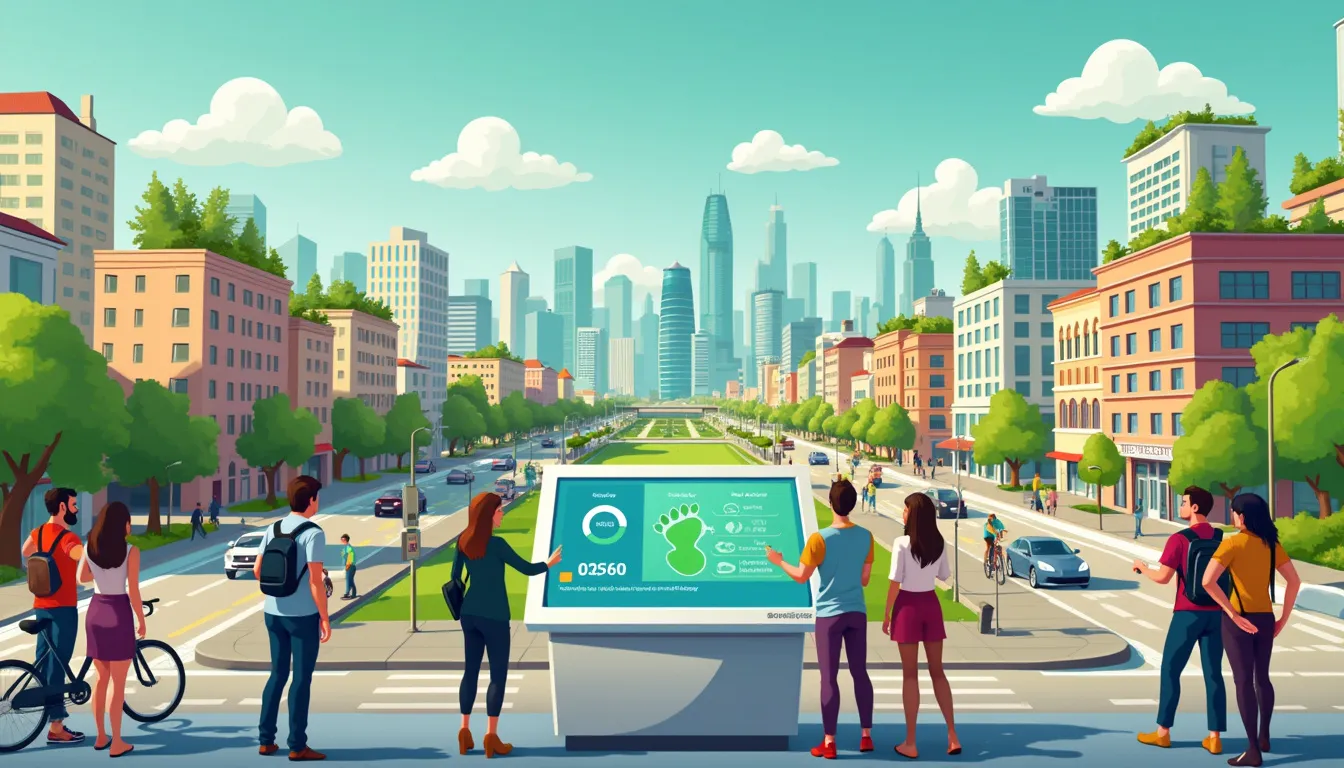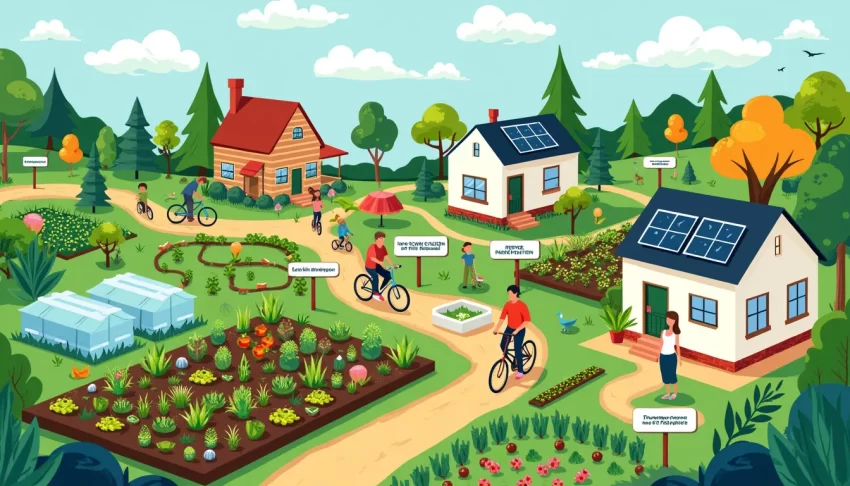In a world where climate change, resource depletion, and pollution are pressing concerns, embracing environmental sustainability is not just a noble pursuit—it’s a necessity. Environmental sustainability, at its core, means meeting our current needs without compromising the ability of future generations to meet theirs. It’s about finding a harmonious balance between economic growth, environmental health, and social well-being.
Why does environmental sustainability matter so much? Well, consider this: Every action we take has a ripple effect on our planet. From the energy we consume to the waste we produce, our daily choices accumulate to form either a positive or negative impact on our environment. The urgency to adopt sustainable practices is underscored by the alarming data indicating rising global temperatures, shrinking ice caps, and increasing pollution levels. But amidst these challenges, there’s a silver lining—we all have the power to make a difference.
In this article, we’ll explore practical steps towards environmental sustainability, tailored for both individuals and businesses. We’ll start by helping you assess your environmental impact, whether at home or in the workplace. You’ll learn how to conduct an environmental audit, focusing on key areas like energy usage, waste production, and water consumption, with the aid of various tools and resources.
Additionally, we’ll delve into actionable steps to reduce your carbon footprint. From adopting energy-efficient practices and reducing waste through recycling and composting, to minimizing single-use plastics, every small change contributes to a larger, positive environmental shift. For those on the move, we’ll examine sustainable transportation options, such as cycling, public transport, and electric vehicles, which can dramatically decrease your impact on the planet.
Furthermore, addressing environmental sustainability isn’t just an individual effort—it’s a collective one. We’ll discuss how you can participate in community and global initiatives, support eco-friendly businesses and products, and advocate for robust environmental policies and legislation. Finally, we’ll highlight the incredible role of technology and innovation in driving sustainable solutions.
By the end of our journey through these topics, you’ll be equipped with knowledge and inspiration to make meaningful changes in your life and business. Let’s take these practical steps together towards a more sustainable future, ensuring a healthier planet for generations to come.
Introduction to Environmental Sustainability
Definition and Importance of Environmental Sustainability
Environmental sustainability is the responsible interaction with the planet to maintain natural resources and avoid jeopardizing the ability for future generations to meet their needs. This concept encompasses a broad range of practices and principles designed to protect the environment by reducing pollution, conserving natural resources, and maintaining biodiversity. It’s not just about doing less harm; it’s about doing more good by proactively finding ways to benefit the ecosystem.
The importance of environmental sustainability cannot be overstated in today’s rapidly industrializing world. As the global population grows and industrial activities intensify, the strain on our planet’s resources becomes more apparent. Policies and practices that promote sustainability ensure that we can continue to enjoy a healthy and functional ecosystem. Beyond the preservation of resources, it also has economic benefits such as cost savings through energy efficiency and innovation leading to new industries and job opportunities.
Why Environmental Sustainability Matters
Environmental sustainability matters on multiple fronts. First and foremost, it is a moral responsibility to ensure that our planet remains habitable for all species, including humans. Deforestation, air, and water pollution, and climate change pose significant threats to biodiversity and human health. By adopting sustainable practices, we can mitigate these threats and create a more balanced, healthy, and equitable world.
In a business context, sustainability matters because it aligns with consumer values and regulatory expectations. Customers are increasingly demanding products and services that are not only high-quality but also environmentally friendly. Companies embracing sustainability are less likely to face legal issues, and they enjoy enhanced brand loyalty. Moreover, sustainable practices often lead to operational efficiencies, reducing costs in the long run.
Additionally, the urgency of climate change dictates the need for immediate action. Reports from the Intergovernmental Panel on Climate Change (IPCC) highlight that the window for preventing the most catastrophic impacts of climate change is closing quickly. By prioritizing environmental sustainability, we contribute to the global effort to limit temperature rise and mitigate associated risks like extreme weather events, food insecurity, and displacement of communities.
Overview of the Article’s Main Points
This article will delve into practical steps toward achieving environmental sustainability, focusing on both personal and professional realms. It will guide you through assessing your environmental impact and offer actionable strategies to reduce your carbon footprint. We’ll also explore broader community and global initiatives, emphasizing how collective action and innovation can drive meaningful change. By the end of this piece, you should feel empowered to make decisions that promote sustainability in your daily life and your business operations.

Assessing Your Environmental Impact
Conducting an Environmental Audit at Home and Work
Understanding your environmental impact is the first step towards sustainability. An environmental audit provides a comprehensive overview of how your daily actions—both at home and at work—affect the planet. By evaluating your energy consumption, waste production, and resource use, you can identify areas where you can make meaningful changes.
At home, this might involve examining your utility bills, scrutinizing your household waste, and assessing your water usage. At work, you may need to look at the company’s energy practices, waste management protocols, and office supply usage. The goal is to gain a clear picture of your impact in various areas to guide your sustainability efforts effectively.
Key Areas to Focus On: Energy Usage, Waste Production, Water Consumption
Energy Usage
Energy consumption is a significant contributor to environmental degradation. Start by examining your energy bills over the past year. Look for patterns and spikes in usage. Are there times of the year when your energy consumption is notably higher? Identify high-energy appliances such as air conditioners, heaters, and kitchen appliances. Consider whether they are running more efficiently and if there are opportunities to reduce their use or upgrade to energy-efficient models.
Waste Production
Next, move on to waste production. Take a week to monitor the waste you generate at home and at work. How much of it can be recycled or composted? Are there items that often end up in the trash that could be avoided with better purchasing choices? At work, consider how materials are disposed of, and whether your company composts organic waste or recycles paper, plastics, e-waste, and other materials. Implementing a rigorous recycling program and encouraging employees to minimize waste can have a substantial impact.
Water Consumption
Water is another vital resource that requires careful management. Assess your water bills to understand your usage patterns. Are you using more water than necessary for activities like gardening, washing dishes, or industrial processes at work? Simple changes such as fixing leaks, installing low-flow fixtures, and practicing mindful water use can greatly reduce your consumption.
Tools and Resources for Measuring Environmental Impact
Fortunately, numerous tools and resources can assist you in measuring and managing your environmental impact. Here are a few to get you started:
- Energy Auditing Tools: Devices like smart meters and energy monitors track your electricity usage in real-time. Online calculators like the EPA’s Power Profiler can help you understand the impact of your energy use.
- Waste Tracking Tools: Apps such as RecycleCoach and iRecycle provide information on how to properly dispose of various materials and track your recycling efforts. For businesses, tools like Green Halo can manage waste and track diversion rates effectively.
- Water Conservation Resources: The Water Footprint Network offers calculators to help you understand and mitigate your water usage. Smart irrigation systems can optimize water use in gardening and landscaping.
By conducting a thorough environmental audit and focusing on key areas such as energy usage, waste production, and water consumption, you can take actionable steps towards environmental sustainability. Utilize the available tools and resources to measure your impact accurately and set realistic goals for improvement. Whether at home or in your business, understanding where you stand is crucial in making informed decisions that favor the environment.

Practical Steps to Reduce Your Carbon Footprint
Reducing your carbon footprint is an empowering and essential element of environmental sustainability. Not only does it help combat climate change, but it also often leads to cost savings and a healthier lifestyle. Below, we delve into practical steps that individuals and businesses can undertake to make substantial environmental impact.
Adopting Energy-Efficient Practices
Energy efficiency is a cornerstone of reducing carbon emissions. Simple changes in how we consume energy can lead to significant reductions in our overall carbon footprint. Let’s explore some feasible steps:
- Switch to LED Lighting: LED bulbs use up to 85% less energy than traditional incandescent bulbs and last up to 25 times longer. For businesses, the initial investment in LED lighting can lead to substantial savings on electricity bills over time.
- Upgrade to Energy-Efficient Appliances: Appliances with the Energy Star label or other energy-efficient certifications consume less power without sacrificing performance. From refrigerators to air conditioning units, these appliances can drastically reduce energy consumption.
- Implement Smart Thermostats: Smart thermostats optimize heating and cooling, ensuring energy isn’t wasted when it’s not needed. These devices learn your habits and adjust settings accordingly, providing comfort and energy savings simultaneously.
- Utilize Renewable Energy: If feasible, install solar panels or subscribe to green energy programs offered by many utility companies. This shift can significantly lower reliance on fossil fuels.
- Conduct Regular Maintenance: Regularly servicing HVAC systems and ensuring insulation is up-to-date can enhance energy efficiency. For businesses, routine checks on machinery can prevent energy wastage and prolong equipment lifespan.
Reducing Waste: Recycling, Composting, and Minimizing Single-Use Plastics
Effective waste management is another critical aspect of environmental sustainability. Minimizing waste not only conserves resources but also reduces greenhouse gas emissions associated with waste disposal. Here are some strategies:
- Implement a Robust Recycling Program: At home and in the workplace, make recycling easy and accessible. Educate everyone on what can and cannot be recycled, and provide clearly labeled bins to encourage correct sorting.
- Start Composting: Composting organic waste, such as fruit peels and coffee grounds, not only reduces landfill load but also produces rich soil that can enhance garden health. Businesses can collaborate with local composting services where individual composting might be impractical.
- Reduce Single-Use Plastics: Opt for reusable products like water bottles, coffee cups, and shopping bags. For businesses, consider eliminating single-use plastics in cafeterias or through procurement policies that prioritize sustainable packaging.
- Practice and Promote Upcycling: Upcycling involves creatively reusing materials that would otherwise be discarded. By turning waste into useful items, both individuals and businesses can reduce the demand for new products and the resources required to produce them.
- Adopt Digital Solutions: Reduce paper waste through digital invoicing, electronic document management, and online marketing materials. This not only cuts down on paper consumption but also simplifies organization and storage.
Sustainable Transportation Options: Cycling, Public Transport, and Electric Vehicles
Transportation is a significant source of carbon emissions. Adopting more sustainable transportation methods can drastically cut down on one’s carbon footprint. Here are some practical steps that can be taken:
- Embrace Cycling: Biking is an excellent zero-emission mode of transport. Cities worldwide are enhancing biking infrastructure, making it a safer and more viable option for daily commutes. Businesses can also support employees who cycle by providing bike racks or offering incentives.
- Use Public Transport: Public transportation systems considerably reduce the number of individual vehicles on roads, thus decreasing traffic congestion and emissions. Encouraging staff to use buses, trains, or shared rides can significantly lower a company’s carbon footprint.
- Transition to Electric Vehicles (EVs): EVs produce zero direct emissions, making them a sustainable option for personal or company use. Governments often offer incentives for purchasing EVs, and businesses can install charging stations to support this shift.
- Carpooling: Sharing rides with colleagues or friends reduces the number of vehicles on roads. For companies, arranging carpool programs or providing ride-sharing incentives can be a part of their sustainability strategy.
- Remote Working Solutions: Reducing the need for commutes through remote work or flexible hours can significantly decrease transportation emissions. This approach has become particularly relevant in the post-pandemic world and can lead to higher productivity and job satisfaction.
By integrating these practical steps into daily routines and business operations, both individuals and organizations can significantly reduce their carbon footprint. This not only contributes to environmental sustainability but also fosters a culture of responsibility and innovation.

Community and Global Initiatives for Sustainability
Participating in Local Environmental Programs and Groups
Being part of a community effort can significantly amplify your impact on environmental sustainability. Many towns and cities have local environmental programs focused on reducing waste, conserving energy, and promoting green spaces. Research shows that communities with strong local programs often see reduced carbon emissions and heightened environmental awareness. Look for neighborhood associations, local non-profits, and community gardens where you can contribute your skills or simply lend a hand.
For example, the Transition Towns movement, which started in the UK, now spans hundreds of communities globally. These groups address everything from local food production to renewable energy projects, proving that collective action can foster substantial change. Not only do these initiatives help the environment, but they also build community resilience and strengthen social ties.
Supporting Eco-Friendly Businesses and Products
Your purchasing decisions have power. By supporting businesses that prioritize sustainability, you drive market demand for eco-friendly products and practices. Start by researching brands that are committed to environmental sustainability. Look for certifications such as Fair Trade, USDA Organic, and Energy Star, which indicate a product meets specific environmental standards.
Supporting local farmers markets, subscribing to community-supported agriculture (CSA) programs, and choosing products with minimal packaging are other practical steps. Many companies now offer sustainable options. For instance, Patagonia donates 1% of its sales to environmental causes and uses recycled materials in its products. By choosing to support such companies, you send a message to the market that sustainability matters.
Advocating for Environmental Policies and Legislation
While individual and community efforts are crucial, advocating for systemic change through environmental policies and legislation can create broader, more lasting impacts. Engage with your local, state, and national representatives to support laws and policies that aim to reduce greenhouse gas emissions, protect natural habitats, and promote renewable energy.
A tangible way to start is by staying informed about environmental issues and participating in public comment periods for proposed legislation. Joining organizations like the Sierra Club or the Natural Resources Defense Council (NRDC) provides resources and collective power to influence policymakers. Additionally, grassroots campaigns and petitions can sway decision-making processes, exemplified by the widespread success of the climate marches led by youth activist Greta Thunberg.
The Role of Technology and Innovation in Achieving Environmental Sustainability
Innovation and technology are game-changers in the realm of environmental sustainability. Advances in renewable energy, smart agriculture, and sustainable manufacturing are key to addressing the pressing challenges we face. For instance, solar and wind energy technologies have made significant strides in efficiency and cost-effectiveness, offering viable alternatives to fossil fuels.
Tech-driven solutions like IoT (Internet of Things) can optimize energy use in homes and businesses by monitoring and adjusting systems in real-time. Likewise, blockchain technology is enhancing supply chain transparency, helping consumers make more informed, sustainable choices.
One inspiring example is the work done by companies utilizing AI to combat deforestation. Organizations like Conservation International are using machine learning to analyze satellite images, detect illegal logging activities, and intervene before substantial damage is done. These sophisticated tools highlight the transformative potential of technology in fostering a more sustainable planet.
Actionable Steps for Supporting Community and Global Sustainability Efforts
1. **Join a local environmental group**: Look for community clean-up events, conservation projects, or sustainability workshops to participate in.
2. **Choose sustainable businesses**: Prioritize companies with strong environmental commitments and certifications.
3. **Engage in advocacy**: Write to your representatives, sign petitions, and participate in public forums to support sustainable policies.
4. **Embrace technology**: Adopt smart home devices to reduce energy consumption, and support tech-driven conservation initiatives.
By actively engaging in these community and global initiatives, we can collectively steer our planet towards a more sustainable future.
As we’ve journeyed through the important facets of environmental sustainability, it’s clear that the steps we take—both large and small—can have a significant impact on our planet. Whether you’re evaluating your daily habits or your business practices, understanding and reducing your environmental footprint is within reach.
Conducting an environmental audit in your home and workplace may seem daunting, but it’s a crucial first step that enables you to pinpoint where you can make the most impactful changes. Focus areas like energy usage, waste production, and water consumption often yield surprising revelations upon closer examination. Leveraging tools and resources to measure and track your progress gives you a tangible sense of achievement and helps maintain momentum.
Adopting energy-efficient practices can range from simple actions, like switching to LED bulbs, to more substantial investments in renewable energy sources. Reducing waste is equally essential, and the strategies are diverse: from committing to a robust recycling and composting regimen to eliminating single-use plastics wherever possible. Transportation, a significant contributor to carbon emissions, offers fertile ground for improvement too. Opting for cycling, public transport, or electric vehicles can collectively make a huge difference.
But environmental sustainability doesn’t stop at your front door. Engaging with community and global initiatives amplifies your efforts and connects you with like-minded individuals and organizations. Participation in local environmental programs, supporting eco-friendly businesses, and advocating for impactful policies help drive collective progress. Technology and innovation also serve as powerful allies, providing new tools and solutions to bolster sustainability efforts.
So, what can you do today? Start with an environmental audit of your immediate surroundings, and identify a few key areas where you can make improvements. Explore energy-efficient upgrades, and revisit your waste management practices. Look into sustainable transportation options for your daily commute. Get involved with local environmental groups and support businesses that prioritize eco-friendly practices. Every small action adds up.
To achieve lasting, meaningful change, embrace a mindset of continuous improvement and collaboration. The journey towards environmental sustainability is ongoing, but each step forward is a step towards a healthier planet for future generations. Remember, we all have a role to play, and together, we can build a sustainable future.
Support Us: Check out our recommended products on Amazon.

